
Uveitis occurs when the uvea (the middle layer of the eye wall) becomes inflamed. The uvea is made up of several parts and includes the iris, the choroid (ring of muscle behind the iris) and the ciliary body (the layer of tissue that supports the retina). Uveitis may affect any one of these parts - the most commonly affected part is the iris. One or both eyes can be affected and symptoms may occur suddenly or gradually over a few days.
Uveitis tends to occur more commonly in people who have a problem with their immune system, such as inflammatory bowel disease (IBD). It can also be caused by an infection, trauma/injury, rare cancers - or in some cases no cause is identified.
It is one of the more common eye complaints associated with IBD. It affects both people with Crohn's disease and ulcerative colitis.
Symptoms can vary slightly depending on where the uveitis is in your eye, but they can include:

If you notice any changes to your vision or the appearance of your eyes it’s important that you get them checked out by your doctor. They may refer you to an eye specialist. Diagnosis of uveitis can be done using a special microscope and light which looks inside the eye. You may also need scans of your eyes.
As mentioned above uveitis can affect different parts of the eye. The diagnosis you are given will depend on which part is affected:
For some people uveitis will be brought on when their IBD flares and inflammation levels in their body are increased.
The treatment you receive will depend on the type of uveitis you have, though it is usually in the form of prednisolone, a corticosteroid (steroid) which is also commonly used to treat IBD. Steroid eye drops tend to be given if the uveitis affects the front of the eye, while steroid injections, tablets or capsules are used to treat uveitis in other areas of the eye.
For some people steroid medication is not enough and they may be given other medication - such as immunosuppressants or eye drops to relieve pain (mydriatic eye drops) as well.
In some cases uveitis clears quickly after starting treatment, others experience repeated episodes (recurrent) or long-term uveitis (chronic).
If uveitis is left untreated it can develop into a disease called glaucoma, damage to the optic nerve, a cataract or problems with the retina. In some cases it can lead to loss of vision.
That's why it's important that you get any eye changes checked out by your doctor.



